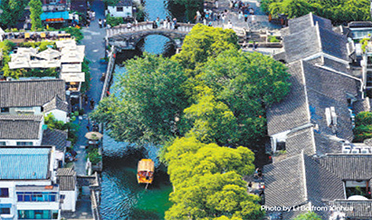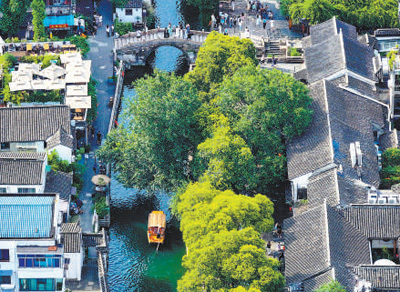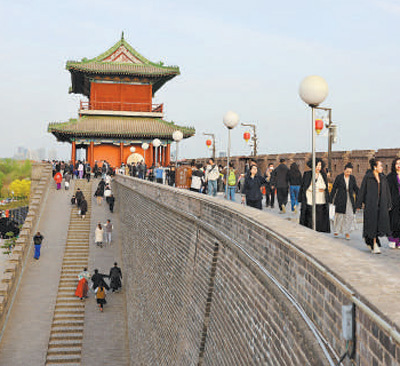



Pingjiang Historical and Cultural District, Suzhou, Jiangsu [Photo by Li Bo from Xinhua]

Tourists visit the ancient city of Zhengding in Shijiazhuang, Hebei [Photo by Zhu Xudong from Xinhua]
A city, as a carrier of national culture and emotional memory, and history and culture are the keys to the charm of a city. Urban historical and cultural heritage is not only the various tangible and intangible cultural heritages, that are distributed within the urban administrative area, but more importantly, they are the city's historic districts, historic urban areas and historical landscapes, which need to be protected and inherited as a whole.
The city's historical and cultural heritage has witnessed the creativity and the spirit of human labor over the past few centuries, and constitutes the collective memory of places and communities. The protection and inheritance of urban historical and cultural heritage will affect all aspects of citizens' lives, and make cities attractive places to live, travel and work through values, cultural traditions and social behaviors, as well as more tangible cultural symbols.
Construct a large-scale protection pattern of historic cities
The protection of famous historical and cultural cities is an important part of the protection of cultural heritage in China. And so far, 142 national historical and cultural cities have been announced, and ancient cities such as Lijiang City and Pingyao City, have also been included in The World Heritage List. The system of famous city protection not only protects a large number of historical and cultural blocks and historical buildings, but also plays an important role in strengthening cultural self-confidence and building a culture-powerful country . Meanwhile,it has also made positive contributions to promoting green urban and rural construction, improving the quality of urban and rural environment, and satisfying people's yearning for a better life.
Cities are important areas for human activities. In the face of climate changes, resource shortage, environmental pollution and other pressures, sustainable development is an unshakable direction, and cities are in a key position in the sustainable construction and development.
It should be noted that a small number of old cities are still faced with insufficient investment, poor management, outdated buildings, aging facilities, and decaying environment, which need saving protection and active rebuilding for community vitality. The protection of urban historical and cultural heritage is essentially a practical activity. Development and protection should be both focused and various urban problems can be solved during the process of practice. According to the notices from relevant departments of the government, the protection and improvement projects of historical and cultural cities and neighborhoods should achieve several no-doings: no large-scale, concentrated demolition of existing buildings; no adding construction in large-scale, and no increasing the pressure on resources and environment; no forcing relocation of residents in large-scale, no changing social structure, and no breaking the linkages among people, places and cultures; no arbitrarily relocating or demolishing historical buildings and old buildings with protection value, and no allowing historical buildings falling into disrepair, repairing but not using, or remaining idle for a long time; no destroying the traditional pattern and street texture, no arbitrarily straightening and widening the road, no building wide roads, and large squares; no destroying the topography and landform, no cutting down old trees and existing trees with local characteristics, no digging mountains and fill lakes, no arbitrarily changing or encroaching on rivers and lakes, no arbitrarily rebuilding parks with historical value, and no arbitrarily changing old place names.
Each famous city has a unique design in terms of culture and space, reflecting the geographical environment, the relationship between people and land, and the historical development context. And as more efforts are made to promote the systematic protection of cultural heritage and build a large-scale protection pattern today, the protection and inheritance of urban historical and cultural heritage is crucially important. In recent years, Beijing, Shanghai, Hangzhou, Fuzhou, Yangzhou, Suzhou and other famous historical and cultural cities have made good practices and explorations in heritage protection and utilization, cultural inheritance and dissemination, which enables that the ancient urban culture can bloom with new brilliance in contemporary society.
The formation process of historical cities includes the rational use and moderate transformation of nature, and accumulates the traditional wisdom of urban space creation. Rational historical spatial forms, pleasant environmental landscapes, low-carbon operation methods, and diverse spatial textures have all created conditions for social inclusion and environmental resilience, which further provide a solid foundation for sustainable urban development in the future.
Protect and activate the memory of urban space
The richness of human life depends on the ability to remember the past, and human memory depends on the spatial and social environment. The city, as the crystallization and cultural memory of the struggle for generations accumulated on the earth, is a social existence that should also be protected as cultural heritage or collective memory.
Historic spaces, such as the old districts, are rich in diversity and preserve a wealth of readable details. Based on assessing the historical fabric of the city and the community environment, a benign mechanism for development planning and urban protection with mutual protection is formed, which regards the historical and cultural heritage of the city as an important measure to improve the quality of life, providing a sustainable urban model for the development of the whole society.
"The old city can't be demolished anymore". This requires local governments to establish better strategies and management mechanisms for the protection of urban historical and cultural heritage in line with the sustainable development goals. The protection of urban historical and cultural heritage is regarded as an important strategic measure to balance urban development and improve the quality of life. It is necessary to integrate the environmental transformation and upgrading of the old city with the protection of historical and cultural heritage and the continuation of the historical context of the city to further maintain the characteristics of historical space, comprehensively improve the living environment of the community, and enable the historical heritage and modern culture complement each other.
A city is not only a place to make life better, but also a place of built environment that regulates people's daily lives and shows what their daily lives look like, and is a living community with values and belief systems. The protection and renewal of urban historical and cultural heritage projects must follow the principles of maintaining the authenticity of cultural heritage, the integrity of historical features, the continuity of social life and the diversity of urban functions. For maintaining the built environment space, the local historical and cultural traditions, lifestyles and ecological environment should be respected, and the sustainability of community culture should be maintained. The practice of protecting and inheriting urban historical and cultural heritage will help improve environmental quality, enhance social cohesion, and promote cultural prosperity and development.
In 2011, in Recommendation on the Historic Urban Landscape, UNESCO established the historic urban landscape approach, which breaks through the past practice that historic buildings and urban spaces are separated from social, environmental and economic aspects, and emphasizes the holistic interconnection between people and the built environment, pays close attention to the connection between the physical space of built heritage and the social, economic and cultural contexts that influence its formation and change.
The protection and practice of China's historical and cultural heritage, from cultural relics and historic sites, historical buildings to the protection of historical and cultural cities, cultural landscapes and other built environmental heritage, is not only an expansion of the spatial scale, but also involves a deeper and more complex social environment. Therefore, it is necessary to strengthen multidisciplinary joint research, especially in the formulation of protection policies and specific engineering practices, and especially to strengthen the sustainable maintenance and management of urban built heritage.
More active protection and more systematic management require greater investment and broader public participation. Cultural heritage is a high-quality asset with potential economic value. The protection and renovation, the revitalization and utilization, the cultural and creative industries development for built heritage can create new employment opportunities; a diverse and inclusive built environment can provide living and working spaces for different groups of people; the living atmosphere, fireworks, and unique urban spaces in the old districts can provide in-depth experience for the development of cultural tourism. The protection and development of achievements should meet the growing needs of the people for a better life and enhance the people's sense of gain, happiness and security, which should also become the purpose of the protection and inheritance of urban historical and cultural heritage.
Author: Zhang Song, Vice Chairman of the Urban Planning History and Theory Branch of Urban Planning Society of China, Professor of Tongji University
Source: <https://m.planning.org.cn/zx_news/15242.htm>
Translated by Wang Yue